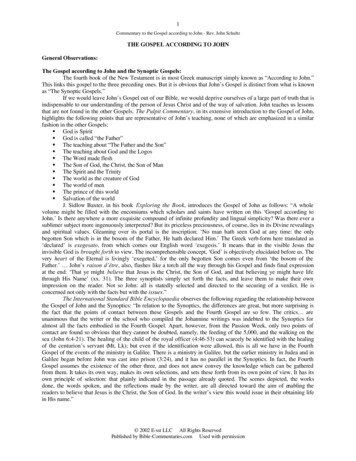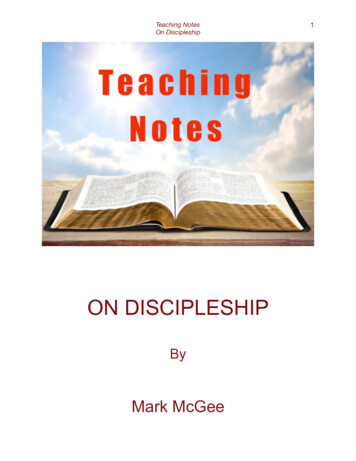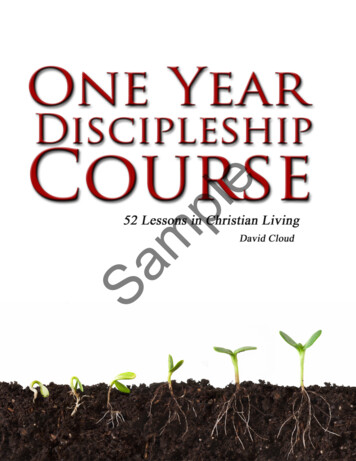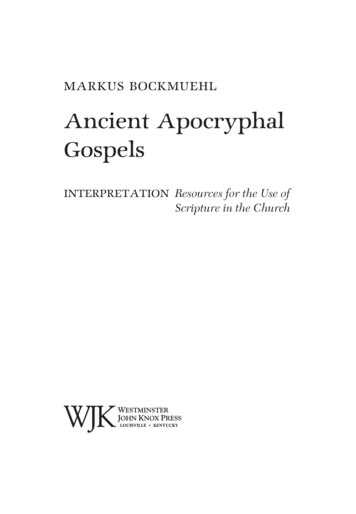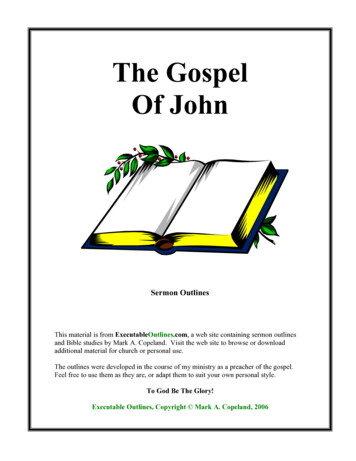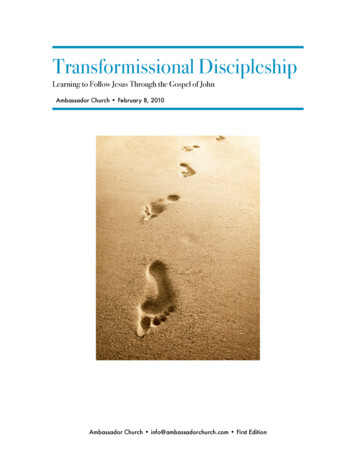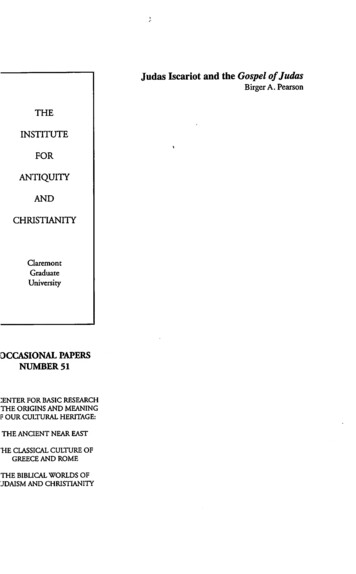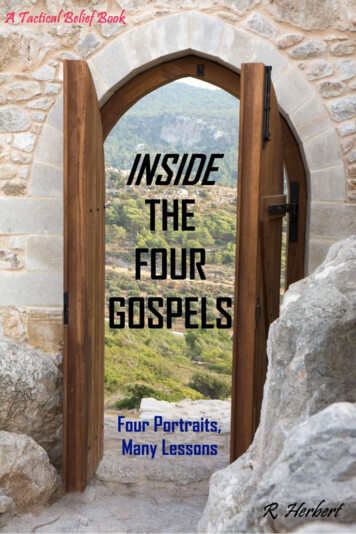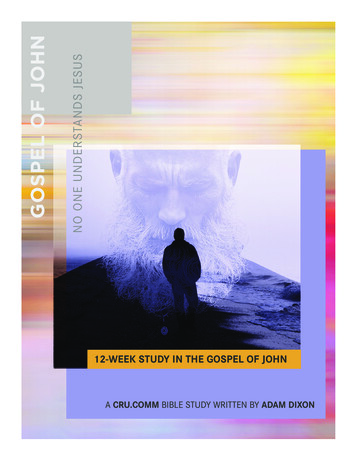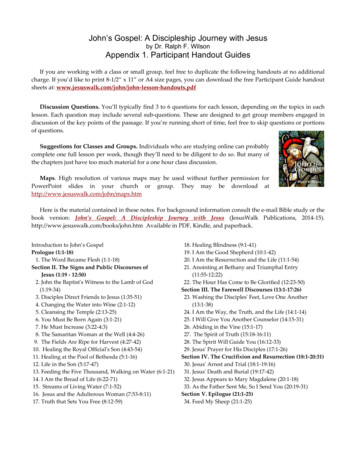
Transcription
John’s Gospel: A Discipleship Journey with Jesusby Dr. Ralph F. WilsonAppendix 1. Participant Handout GuidesIf you are working with a class or small group, feel free to duplicate the following handouts at no additionalcharge. If you’d like to print 8‐1/2” x 11” or A4 size pages, you can download the free Participant Guide handoutsheets at: fDiscussion Questions. You’ll typically find 3 to 6 questions for each lesson, depending on the topics in eachlesson. Each question may include several sub‐questions. These are designed to get group members engaged indiscussion of the key points of the passage. If you’re running short of time, feel free to skip questions or portionsof questions.Suggestions for Classes and Groups. Individuals who are studying online can probablycomplete one full lesson per week, though they’ll need to be diligent to do so. But many ofthe chapters just have too much material for a one hour class discussion.Maps. High resolution of various maps may be used without further permission forPowerPoint slides in your church or group. They may be download athttp://www.jesuswalk.com/john/maps.htmHere is the material contained in these notes. For background information consult the e‐mail Bible study or thebook version: John’s Gospel: A Discipleship Journey with Jesus (JesusWalk Publications, 2014‐15).http://www.jesuswalk.com/books/john.htm Available in PDF, Kindle, and paperback.Introduction to John’s GospelPrologue (1:1‐18)1. The Word Became Flesh (1:1‐18)Section II. The Signs and Public Discourses ofJesus (1:19 ‐ 12:50)2. John the Baptistʹs Witness to the Lamb of God(1:19‐34)3. Disciples Direct Friends to Jesus (1:35‐51)4. Changing the Water into Wine (2:1‐12)5. Cleansing the Temple (2:13‐25)6. You Must Be Born Again (3:1‐21)7. He Must Increase (3:22‐4:3)8. The Samaritan Woman at the Well (4:4‐26)9. The Fields Are Ripe for Harvest (4:27‐42)10. Healing the Royal Officialʹs Son (4:43‐54)11. Healing at the Pool of Bethesda (5:1‐16)12. Life in the Son (5:17‐47)13. Feeding the Five Thousand, Walking on Water (6:1‐21)14. I Am the Bread of Life (6:22‐71)15. Streams of Living Water (7:1‐52)16. Jesus and the Adulterous Woman (7:53‐8:11)17. Truth that Sets You Free (8:12‐59)18. Healing Blindness (9:1‐41)19. I Am the Good Shepherd (10:1‐42)20. I Am the Resurrection and the Life (11:1‐54)21. Anointing at Bethany and Triumphal Entry(11:55‐12:22)22. The Hour Has Come to Be Glorified (12:23‐50)Section III. The Farewell Discourses (13:1‐17:26)23. Washing the Disciplesʹ Feet, Love One Another(13:1‐38)24. I Am the Way, the Truth, and the Life (14:1‐14)25. I Will Give You Another Counselor (14:15‐31)26. Abiding in the Vine (15:1‐17)27. The Spirit of Truth (15:18‐16:11)28. The Spirit Will Guide You (16:12‐33)29. Jesusʹ Prayer for His Disciples (17:1‐26)Section IV. The Crucifixion and Resurrection (18:1‐20:31)30. Jesusʹ Arrest and Trial (18:1‐19:16)31. Jesusʹ Death and Burial (19:17‐42)32. Jesus Appears to Mary Magdalene (20:1‐18)33. As the Father Sent Me, So I Send You (20:19‐31)Section V. Epilogue (21:1‐25)34. Feed My Sheep (21:1‐25)
John’s Gospel: A Discipleship Journey with Jesus. Participant Guide Handout2Introduction to John’s GospelJohn’s Gospel is dramatically different than the Synoptic Gospels (meaning similar Gospels, “presenting thesame view”) – Matthew, Mark, and Luke. These first three Gospels share, to some degree, a similar source, andoften have passages that seem almost the same word‐for‐word as in the others.But John’s Gospel is in a class by itself. It draws upon a separate, independent gospel tradition. It’s as if theSynoptic Gospels tell the story of Jesus’ life, miracles, parables, and teaching, letting readers draw their ownconclusions. But John is very selective in the events he includes. And when he does include a miracle, he oftenleads us to ponder its meaning in a discourse. John’s Gospel, written late in the apostle’s life, is full of thoughtful,theological reflection.Authorship. The nearly unanimous tradition of the early church is that John the Apostle, son of Zebedee, isthe author of the Gospel that bears his name. And editor records, “. The disciple whom Jesus loved . this is thedisciple who testifies to these things and who wrote them down.” (21:20, 24). It’s quite clear that this was John theApostle.Most scholars see the date of John’s Gospel as comparatively late, probably in the 90s AD. John seems toassume that his readers are acquainted with the facts of Jesus as given in the Synoptic Gospels. Several earlytraditions place the Apostle John as Bishop of Ephesus at the end of his life. John probably penned his Gospel inEphesus.Purpose. “These are written that you may believe that Jesus is the Christ, the Son of God, and that by believingyou may have life in his name” (John 20:30‐31). John seems to have an evangelistic purpose that guides hisselection of material. John probably wrote to convince unbelieving Greek‐speaking Jews and Gentiles.John and the Synoptics. Differences from the Synoptic Gospels include John’s longer discourses, rather thanparables and brief sayings; A focus on eternal life more than on the Kingdom of God; fewer miracles, but anemphasis on them as “signs” of who Jesus is; a strongly theological prologue, that begins by telling us just whoJesus is; no Christian baptism or sacraments mentioned; ministry primarily in Judea and Jerusalem, with less onhis Galilean ministry; a focus on Jewish feasts, especially on the Passover; and an emphasis on the tragedy ofJesus’ rejection by his own people and their leaders.Theology. John is an intensely theological book. Some of the strongest themes include: the Jesus as the Wordor Logos, God as Father, the “I Am” sayings, Jesus as Son of God, Jesus as the Christ, miracle signs and theirrelationship to true faith, salvation, life – especially eternal life, and the Holy Spirit as Paraclete.Style. John’s style includes (1) purposeful twofold or double meanings; (2) misunderstanding, where Jesus isspeaking on the heavenly level, but he is misunderstood as speaking to a material or earthly situation; irony inderogatory statements by Jesus’ enemies; and explanatory notes.“The Jews” in John’s Gospel. Most of the Synoptic Gospels use the term “the Jews” rarely, and usually in thephrase “King of the Jews.” However, John’s Gospel uses it 70 times. The adjective Ioudaios is literally, “Judean.”John seems to use it to describe Jews of the Judean area – speaking from the perspective of a Galilean, usually torefer to the Jewish leaders from Judea who are hostile to Jesus.Religious Leaders in Jesus’ Day.Copyright 2015, Ralph F. Wilson. All rights reserved. Permission is granted to reprint these notes for local churches, classes, and groups.Taken from Ralph F. Wilson, John’s Gospel: A Discipleship Journey with Jesus (JesusWalk, 2015). www.jesuswalk.com/books/john.htm
John’s Gospel: A Discipleship Journey with Jesus. Participant Guide Handout31.Pharisees belonged to a lay movement or party that defined righteousness as observing every detail oftraditional rules designed to serve as a “hedge” or “fence” around the commandments in the Torah orPentateuch, akin to modern‐day Hasidic Jews.2.High priests were appointed by Herod, and served at the pleasure of the Roman Governor, so the highpriests were often closely aligned with Roman interests.3.Sadducees were a group closely identified with the priestly aristocracy. They rejected the oral law or“traditions of the elders,” and held rather to the Torah itself. They denied the resurrection and angels orspirits.4.“Scribes” (KJV) or “teachers of the law” (NIV) were a class of professional exponents and teachers of thelaw, either Sadducees or Pharisees. They were respected teachers who often had pupils who studied thelaw with them.5.“Lawyers” (KJV) or “experts in the law” (NIV) is another word for “scribe.”6.“Rabbi” (KJV and NIV) is a respectful form of address for all teachers that means, literally, “great one.”In Jesus’ day it was not yet a fixed title for academically schooled, ordained scribes as it became later, andis in our day.7.“Teacher” (NIV) or “master” (KJV), usually translates the Hebrew/Aramaic word rabbi.Where it was possible, the Romans would have had a provincial governor who represented Roman authority,but sought to keep in place the local kingdoms and administrative systems that were native to a country (clientkingdoms or vassals). The Romans had ruled Israel since 36 BC, recognizing Herod the Great as King of the Jews.After Herod’s death his kingdom was divided into four tetrarchies, each ruled by one of his sons. During Jesus’time, Herod Antipas was tetrarch over Galilee, who beheaded John the Baptist, and before whom Jesus appearedat his trial.While the Romans and Herodian kings held civil power, the Jewish Sanhedrin acted as a ruling body for theJewish people. The “Great Sanhedrin” in Jerusalem consisted of 71 members (Exodus 24:1; Numbers 11:16, 24‐25),though lesser decisions could be made by a panel of 23 members. In Jesus’ day, the Great Sanhedrin functioned asboth a supreme court, as well as legislature, and was made up of members of the nobility (Sadducees, bothpriestly and lay), and scholars in the law (mainly Pharisees).Copyright 2015, Ralph F. Wilson. All rights reserved. Permission is granted to reprint these notes for local churches, classes, and groups.Taken from Ralph F. Wilson, John’s Gospel: A Discipleship Journey with Jesus (JesusWalk, 2015). www.jesuswalk.com/books/john.htm
John’s Gospel: A Discipleship Journey with Jesus. Participant Guide Handout41. The Word Became Flesh (John 1:1-18)“Word,” logos is “the independent personified expression of God.”Q1. (John 1:1‐3) According to the Apostle John, is Jesus fully God? What does it mean that Jesus is the“Word”? What does this say about him and his ministry?In Genesis 1:3, light is created by God’s Word:John introduces the theme of a war between spiritual light and darkness that pervades his Gospel (John 1:4‐5,7‐9; 3:19‐21; 8:12; 9:5; 11:9‐10; 12:35‐36, 46).John the Baptist was: Jesus’ cousin, just about six months older than Jesus (Luke 1:36‐66). Lived in the desert (Luke 1:80; 3:2). Ministered along the Jordan River east of Jerusalem “preaching a baptism of repentance for the for‐giveness of sins” (Luke 3:3). Attracted a large following from Jerusalem and Judea (Matthew 3:5; Mark 1:5). Denounced the religious hypocrites (Luke 3:7‐8). Demanded love and justice of those who sought baptism (Luke 3:10‐14). Proclaimed that one who came after him would baptize with the Holy Spirit and fire (Luke 3:16‐17). Rebuked Herod Antipas, Tetrarch of Galilee and Perea, for adultery and incest, and was imprisoned(Luke 3:19‐20) and later beheaded because of the tetrarch’s wife Herodias’s anger at John’s rebuke (Mat‐thew 14:3‐12). Baptized Jesus (Luke 3:21). Was widely considered to be a prophet (Mark 11:32), and declared to be one by Jesus (Matthew 11:9). A Nazirite (Luke 1:15; Matthew 11:18). A righteous and holy man (Mark 6:20). Jesus said that he fulfilled the prophecy that Elijah should return (Matthew 17:12‐13; Mark 9:13).Q2. (John 1:7‐8) What did it mean that John was sent to “testify” to the light? In what sense are you put herewith the purpose of “testifying” to the light? How are you doing in this regard? What happened to John theBaptist? What might happen to you if you testify clearly? What might happen to the people to whom youtestify?Q3 (John 1:12‐13) What does it mean to “receive” Jesus? What does it imply to “believe in” Jesus? What is thespiritual relationship to God of those who receive and believe in Jesus? Of those who do not?“One and Only” (NIV), “only Son” (ESV, NRSV), “only begotten” (KJV) is the adjective monogenēs, “one andonly, only.” Here, “pertaining to being the only one of its kind or class, unique (in kind),” of something that is theonly example of its category.Q4. (John 1:14) Why is the idea of God “becoming flesh” so important to the basis of the Christian faith? Whatwould Christ’s life, crucifixion, and resurrection mean if he were only pretending to “become flesh”? In whatCopyright 2015, Ralph F. Wilson. All rights reserved. Permission is granted to reprint these notes for local churches, classes, and groups.Taken from Ralph F. Wilson, John’s Gospel: A Discipleship Journey with Jesus (JesusWalk, 2015). www.jesuswalk.com/books/john.htm
John’s Gospel: A Discipleship Journey with Jesus. Participant Guide Handout5ways have you personally experienced his grace? In what ways has his truth changed your life from what itwas?Q5. (John 1:18) What does it mean that Jesus is the “Only God” or the “Only Begotten God”? Does the ApostleJohn seem to make a distinction between God the Father and God the Son? What does all this mean for ourunderstanding of the Trinity?Lessons for Disciples1.Jesus is fully divine. He is God (1:1).2.Jesus is the full expression of God the Father (1:1).3.Jesus is not a created being, rather he was delegated the task of creation (1:2‐3).4.Jesus is the source of life and truth for mankind (1:4).5.Jesus was rejected by his own people (1:11).6.Only those who believe and receive Jesus have “authority” to be called God’s children (1:12).7.Jesus (the Word) became human (flesh) and showed us God’s glory (1:14).8.9.Jesus brings grace and truth (1:14, 17).Jesus is the One and Only God (1:18).Copyright 2015, Ralph F. Wilson. All rights reserved. Permission is granted to reprint these notes for local churches, classes, and groups.Taken from Ralph F. Wilson, John’s Gospel: A Discipleship Journey with Jesus (JesusWalk, 2015). www.jesuswalk.com/books/john.htm
John’s Gospel: A Discipleship Journey with Jesus. Participant Guide Handout62. John the Baptist’s Witness to the Lamb of God (John 1:19-34)John the Baptist seems to have been well known in Jewish circles as a revivalist. Josephus records severalparagraphs about him (Josephus, Antiquities, xviii. 5.2). Peter refers to John the Baptist as he preaches about Jesusin the Roman city of Caesarea. Paul speaks of him in a synagogue in Pisidian Antioch on his first missionaryjourney (Acts 13:24). Even as far away as Ephesus in about 52 AD, Paul finds a zealous Jew from Alexandria who“knows only the baptism of John” (Acts 18:25).People wondered if John were: (1) the Messiah or Christ, (2) Elijah. (Malachi 4:5); or (3) The Prophet referredto by Moses (Deuteronomy 18:15).Q1. (John 1:19‐23) Why do you think John the Baptist was being hassled by the religious leaders fromJerusalem? What were they afraid of? How did John understand his own mission? How much conflict do youthink could be expected from John’s mission?Q2. (John 1:26‐27) Why did John baptize? What is the meaning of the baptism he was performing? What doyou think baptism represents to those John baptized?Q3. (John 1:19‐27) How does John the Baptist show humility? How can a person see himself as the fulfillmentof a passage from Isaiah and still be humble about it? How does John see himself in relation to the comingMessiah? How can a person be such a strong revivalist preacher and still remain humble? Can humility andpowerful, confident speech co‐exist?Q4. (John 1:29) What does the title “Lamb of God” tell us about Jesus’ ministry? According to 1:29, whose sinsdid he come to take away? In what ways did Jesus fulfill Isaiah 53?Ways John describes the coming of the Holy Spirit using various analogies and figures: “Born of the Spirit” (3:6, 8), “born from above/again” (3:6).Worship “in Spirit and in truth” (4:24).“Rivers of living water” flowing out of one’s heart (7:38‐39), offered to “whoever believes in me.”“The Spirit of truth,” who is with you and will be in you (14:16‐17) – another Counselor (GreekParaklētos), the indwelling Spirit.The Spirit (Paraklētos) who will teach and remind believers of what Jesus said (14:26).The Spirit (Paraklētos) who testifies of Jesus (15:26).The Spirit (Paraklētos) who will guide us into all truth (16:13‐15), and who will convict the world of sin(16:8‐11).The Spirit Whom Jesus breathed upon his disciples – “Receive the Holy Spirit” (20:22).Copyright 2015, Ralph F. Wilson. All rights reserved. Permission is granted to reprint these notes for local churches, classes, and groups.Taken from Ralph F. Wilson, John’s Gospel: A Discipleship Journey with Jesus (JesusWalk, 2015). www.jesuswalk.com/books/john.htm
Q5. (John 1:33) How does John the Baptist’s baptism differ from the baptism that Jesus brings? Baptism is aword that means “immerse, plunge under water.” What does a “baptism of the Holy Spirit” imply about thisevent?Lessons for Disciples1.John humbly and faithfully fulfilled his mission, which he saw clearly enough, even though he may nothave fully understood how he fit into God’s plan (1:23).2.Jesus is the “Lamb of God,” God’s sacrifice for our sins, prophesied in Isaiah 53 and fulfilled on the cross.Jesus’ mission was to take away our sins (1:29).3.John realizes that his job is to reveal Christ to Israel – and he’s okay about that, even though he doesn’tget to take the glory for himself (1:30).4.Jesus baptizes with the Holy Spirit, that is, he floods people with his Holy Spirit (1:33).5.Jesus is the Son of God (1:34).
John’s Gospel: A Discipleship Journey with Jesus. Participant Guide Handout83. Disciples Direct Friends to Jesus (John 1:35-51)Q1. (John 1:35‐37) Upon whose recommendation did Andrew andanother person start following Jesus? What did this recommenda‐tion cost the recommender in this case?Q2. (John 1:38‐39) Why doesn’t Jesus tell his inquirers where he isstaying? Why was it important for disciples to “be with” Jesus?What does “being with” Jesus mean today?Q3. (John 1:40‐42) What role does Andrew play in Simon Peter’sconversion? Today, why do so many Christians substitute bringing aperson to Jesus with bringing them to church? What might be thesimilarities? What might be the differences?Jesus seems to have been exercising what is sometimes referred to as the “word of knowledge” (1 Corinthians12:8), some kind of supernatural prophetic insight into a person’s life or needs, something like an ancient “seer”might have. This gift in our day can result in faith and salvation. Let’s honor it in our churches and not neglect it.Jesus is our exemplar in this.Q4. (John 1:45‐50) How does Jesus deal with Nathanael’s skepticism? What was the nature of the miracle?Upon coming to faith, what title does Nathanael bestow upon Jesus?Q5. (John 1:50‐51) Which aspects of Daniel’s prophecy in Daniel 7:13‐14 does Jesus apply to his title as Son ofMan? When will the Son of Man complete his ministry?Lessons for Disciples1.Friends often become disciples by being pointed to Jesus by their friends. It is a natural way of becominga disciple. We must trust our friends to Jesus, rather than keep them for ourselves without “ruining” afriendship by mentioning “religion.”2.Jesus is called by several titles in this passage: Messiah (Christ, 1:41), Son of God (1:49), King of Israel(1:49), and Son of Man (1:51).3.Jesus exercises the “spiritual gift” of the “word of knowledge” (1 Corinthians 12:8) to convince people ofwho he is. We need to draw on spiritual gifts to convince people of who Jesus is.4.Jesus gives Peter a “new name” that signifies what his future role will be. God may have some role foryou that is far beyond what you can imagine.Copyright 2015, Ralph F. Wilson. All rights reserved. Permission is granted to reprint these notes for local churches, classes, and groups.Taken from Ralph F. Wilson, John’s Gospel: A Discipleship Journey with Jesus (JesusWalk, 2015). www.jesuswalk.com/books/john.htm
John’s Gospel: A Discipleship Journey with Jesus. Participant Guide Handout94. Changing the Water into Wine (John 2:1-12)Marriage in Jesus’ day begins with a betrothal up to a year beforethe marriage celebration. The man and woman enter into a bindingagreement to marry, more binding than our “engagement” in theWest. The man gives the bride’s father a bridal gift, a form ofcompensation to the father (some of which becomes a dowry thefather gives to the daughter at the marriage to help provideeconomic stability to the marriage bond). The couple doesn’t livetogether or consummate the marriage at their betrothal, though theyare considered husband and wife, and the bond cannot be brokenwithout divorce.A marriage in this culture is a celebration. The groom and his friends go to the bride’s home, and then escortthe bride in a festive procession to the groom’s home, where a grand celebration takes place. There is probably anexchange of vows and some kind of religious ceremony, though none of these details survive from the firstcentury AD. The groom gives his bride gifts. After the marriage feast, the bride and groom enter the nuptialchamber and the marriage is consummated.Q1. (John 2:1‐2) Why are we sometimes “too busy” to spend time with friends and relatives? What does Jesus’attendance at this wedding tell us about him? How can we apply that learning in our own personal lives?Throughout the Gospels, we see Jesus’ clear awareness that he must not plunge into fame too quickly. That iswhy he tells people on certain occasions not to tell everybody about their miracle (Mark 1:43‐45; 7:36) or that he isthe Messiah (Mark 8:29‐30 Matthew 16:20; Mark 9:9 Luke 9:36 Matthew 17:9). His hour had not yet come,and manipulating publicity would force that “hour” to come before he can train his disciples for their Kingdomwork. Jesus’ eyes were clearly on his chief purpose, but he isn’t in a hurry. There is no rush.Q2. (John 2:3‐5) Why do you think Mary pushes Jesus to solve the wedding host’s problem? Are her words toJesus appropriate? Would you categorize Jesus’ reply as a rebuke? If so, why does he go ahead with themiracle?In the so‐called “Burnt House” in the Jewish Quarter of the Old City of Jerusalem, archaeologists foundseveral stone water jars from the first century AD. They are 2 to 2.5 feet high (65‐80 cm.), shaped from limestoneon some kind of very large lathe. They held about 17 gallons (80 liters), and were covered by a flat piece of stone.In Capernaum, several stone jars from the fourth century AD have been found in the synagogue there. See Mark7:3‐4.Q3. (John 2:6‐10) Why do you think alcoholics are quick to point out this miracle? Which is wrong: drinkingwine or drunkenness? How can we avoid excesses and still enjoy God’s good gifts?Q4. (John 2:6‐10) Why did Jesus perform this miracle behind‐the‐scenes? Who was he trying to protect? Whatdoes the quantity of the wine tell us about Jesus’ glory? What does the quality of the wine tell us about Jesus’glory?“Miraculous signs” (NIV), “signs” (NRSV), “miracles” (KJV) is the plural of sēmeion, “a sign or distinguishingmark whereby something is known, sign, token, indication.” Here, “an event that is an indication or confirmationCopyright 2015, Ralph F. Wilson. All rights reserved. Permission is granted to reprint these notes for local churches, classes, and groups.Taken from Ralph F. Wilson, John’s Gospel: A Discipleship Journey with Jesus (JesusWalk, 2015). www.jesuswalk.com/books/john.htm
John’s Gospel: A Discipleship Journey with Jesus. Participant Guide Handout10of intervention by transcendent powers, miracle, portent.” Sēmeion is one of the characteristic words used in John(2:11, 18; 4:54; 6:2, 14, 26, 30; 7:31; 9:16; 10:41; 11:47; 12:18, 37; 20:30).Lessons for Disciples1.Celebrations with family and friends are important to Jesus – and should be to us. We shouldn’t feelourselves too spiritual or too busy for such earthly joys and responsibilities.2.It’s possible to try to push God into acting on our behalf. It’s best to be less pushy than Jesus’ mother, orwe may be rebuked like she was.3.Jesus is not against wine. It’s drunkenness that is wrong, the misuse of God’s gifts, not wine itself.4.Miracles need not be showy or even trumpeted to others. To meet the need is enough. Jesus was not ashowman.Copyright 2015, Ralph F. Wilson. All rights reserved. Permission is granted to reprint these notes for local churches, classes, and groups.Taken from Ralph F. Wilson, John’s Gospel: A Discipleship Journey with Jesus (JesusWalk, 2015). www.jesuswalk.com/books/john.htm
John’s Gospel: A Discipleship Journey with Jesus. Participant Guide Handout115. Cleansing the Temple (John 2:13-25)The first temple was built by Solomon on Mount Moriah inJerusalem about 950 BC to replace the tabernacle that had beenIsrael’s portable place of worship, first in the wilderness at Sinaiand for the next several hundred years at Shiloh. Solomon’sTemple was destroyed in 587 BC when Nebuchadnezzar’s armydestroyed Jerusalem. The next temple was built when the Jewsreturned from exile under Zerubbabel in about 515 BC. It wasdamaged, plundered, and desecrated by Greek conquerorAntiochus Epiphanes in 167 BC and later by Roman generalsPompey in 63 BC and Crassus in 54 BC. Herod the Greatdestroyed some of the temple walls as he stormed Jerusalem in 37BC.Herod the Great, now King of the Jews under the Romans,began to rebuild the temple in 20‐19 BC, a process that continuedfor most of the next decade, with further ornamentationcontinuing perhaps through the 60s AD (cf. 2:20). Since Herod’s Temple was constructed over the foundation ofthe temple built under Zerubbabel in 515 BC (though greatly expanded), it is known by Jews today as the SecondTemple. Remnants of this temple are still visible today in the Wailing Wall at the base of its Western Wall.1.2.3.4.5.Court of the Gentiles was the outermost court. Jesus and his disciples – and later the early church – metunder Solomon’s Porch on the east side of the temple complex (10:23; Acts 3:11; 5:12). Gentiles as well as Jewswere allowed to be there. Here sacrificial animals were sold and money exchanged.Court of Women was divided from the Court of the Gentiles by a stone balustrade, perhaps 4.5 feet high,where women, but not Gentiles, could come and pray.Courts of Israel and of the Priests were accessible from the Nicanor Gate on the west side of the Court ofWomen. Within the Court of the Priests were the altar, laver, various chambers, and the Temple buildingitself.Temple Building. The front of the temple building was 150 feet wide and high, a gilded spectacle that wasthe wonder of all. The Second Temple as finally destroyed by the Romans under Titus in 70 AD, and has notbeen rebuilt.Tyrian coinage (from Tyre) is specified in the Mishnah as the only coinage acceptable for the temple tax, butthere was a fee to exchange one’s coins for the Tyrian coins. The chief priest controlled the entire enterprise ofmoney‐changing and sale of sacrificial animals – and got his percentage of the gross.Q1. (John 2:14‐17) What was going on in the temple? Why was Jesus offended by it? What action did Jesustake?Q2 (John 2:11‐17) Apparently, Jesus was angry. Was his anger justified? Why? Is anger good or bad? Whatabout anger gets us into trouble?Q3. (John 2:23‐25) What is the problem with faith that rests solely on miracles? Is it true faith? What isnecessary for it to develop into true faith? Did Jesus see these problems as a reason not to perform miracles?Copyright 2015, Ralph F. Wilson. All rights reserved. Permission is granted to reprint these notes for local churches, classes, and groups.Taken from Ralph F. Wilson, John’s Gospel: A Discipleship Journey with Jesus (JesusWalk, 2015). www.jesuswalk.com/books/john.htm
John’s Gospel: A Discipleship Journey with Jesus. Participant Guide Handout126. You Must Be Born Again (John 3:1-21)In John 3:1‐8, Jesus tells that: (1) the Kingdom is spiritually discerned, that is, you can’t see it or grasp itspiritually unless you are “born from above,” unless God enables you to see it and (2) the Kingdom is spirituallyentered, that is, you can’t enter into the Kingdom, which is a synonym for inheriting eternal life, unless you arechanged spiritually.Q1. (John 3:3, 5) What does Jesus teach here about the nature of the Kingdom of God? Do you thinkNicodemus understands him? Why or why not?The word “born” is gennaō, “become the parent of, beget” by procreation. The passive can mean either,“born,” as by a mother, or “begotten,” as by a father. Nicodemus takes the word in its feminine sense of being inone’s mother’s womb. But elsewhere, the idea seems to be “beget” in the masculine sense (John 1:12‐13; 1 John3:9; 5:1; 1 Peter 1:23).Greek anōthen. The Greek word can have both the meaning “from above” (which is most common) as well as“again, anew” (less common). Probably the translation “born anew” reflects Jesus’ meaning here, but probablyJohn deliberately used the ambiguous adverb anōthen so that both ideas of “anew” and “from above” would beconsidered, since the spiritual birth is both “anew” and “from above.”Q2. (John 3:3‐5) What does “entering the Kingdom” have to do with being “born anew”? Which do you thinkis the best translation here: “born again,” “born anew,” or “born from above”? Defend your reasoning.“Water and Spirit. Water could refer to: (1) Christian baptism, (2) waters of procreation (semen, bag of waters),or (3) Repentance and Purification. Dipping in water naturally suggests washing and cleansing, the previouscontext is the water of John’s baptism (Mark 1:4, 8; John 1:33; Luke 7:30).Q3. (John 3:5‐7) What does it mean to be “born of water and the Spirit”? What do you think “water” refers to?Why have you come to this conclusion? How, then, would you paraphrase “born of water and the Spirit” tobest bring out the full meaning?“Wind” in 3:8 is pneuma, the breath of God, the same word that is translated “Spirit” at the end of the verse.Jesus’ self‐descriptive title of “Son of Man” in 3:13 is taken from a passage in Daniel 7:13‐14. Verse 14‐15 referto a bronze snake that Moses fashioned in the wilderness at a time when people were being bitten by snakes(Numbers 21:8‐9). A bronze snake was lifted up on a pole for people to
Introduction to John’s Gospel John’s Gospel is dramatically different than the Synoptic Gospels (meaning similar Gospels, “presenting the same view”) – Matthew, Mark, and Luke. These first three Gospels share, to some degree, a similar source, and often have passages that see
